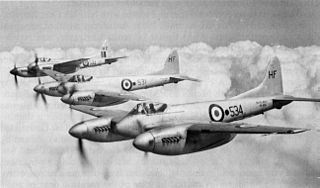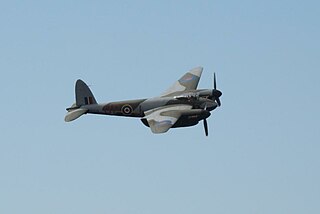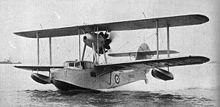
Royal Naval Air Station Lee-on-Solent,, is a former Royal Naval Air Station located near Lee-on-the-Solent in Hampshire, approximately 4 miles (6.44 km) west of Portsmouth, on the coast of the Solent.

736 Naval Air Squadron was a Naval Air Squadron of the Royal Navy's Fleet Air Arm. It was most recently recommissioned at HMS Seahawk, RNAS Culdrose in June 2013 to fly the BAE Systems Hawk, mainly in the maritime aggressor role, following the disbandment of the Fleet Requirements and Aircraft Direction Unit (FRADU) and operated up until March 2022. It initially formed as the School of Air Combat in May 1943 at HMS Heron, RNAS Yeovilton. In September 1943 it moved to HMS Vulture, RNAS St Merryn, where it became the Fighter Combat School and it created an independent 'B' Flight for fighter affiliation work between March and September 1945. 736 Naval Air Squadron moved to HMS Seahawk, RNAS Culdrose in February 1950 as the Naval Air Fighter School in the 52nd Training Air Group, but disbanded in August 1952. Immediately the following day, the squadron reformed at HMS Seahawk, RNAS Culdrose out of 702 Naval Air Squadron as an Advanced Jet Flying School and in November 1953 it moved to HMS Fulmar, RNAS Lossiemouth. 736 Naval Air Squadron disbanded there in March 1965, but what was left became 764 Naval Air Squadron ‘B’ Flight. The squadron reformed the same day at Lossiemouth from 809 Naval Air Squadron as a Jet Strike Training Squadron. 1966. In March 1967, its aircraft were part of the group that bombed and set on fire the supertanker SS Torrey Canyon aground and leaking crude oil on Seven Sisters rocks off Cornwall. The squadron disbanded in February 1972.

778 Naval Air Squadron was a Naval Air Squadron of the Royal Navy's Fleet Air Arm. During the Second World War the squadron was a Service Trials Unit (STU) initially based at HMS Daedalus, RNAS Lee-on-Solent, Hampshire, England before moving to HMS Condor, RNAS Arbroath, Angus, Scotland on 6 July 1940. The squadron tested all types of aircraft that could be used by the Royal Navy. Key to this was testing new types for deck landing on aircraft carriers. Such aircraft included various types of Supermarine Seafires, Grumman Hellcats, Grumman Martlets, Grumman Avengers, and Vought Corsairs. The squadron was reformed on 5 November 1951 with Douglas Skyraider AEW.1 but was disbanded on 7 July 1952 to form the basis of 849 Naval Air Squadron.

738 Naval Air Squadron was a Naval Air Squadron of the Royal Navy's Fleet Air Arm (FAA), which last disbanded during May 1970 at HMS Goldcrest, RNAS Brawdy. It initially formed as a Pilot Training Squadron formed at HMS Asbury, RNAS Quonset Point, Rhode Island, in February 1943. The squadron moved to RNAS Lewiston, Maine, United States, at the end of July 1943 and also providing advanced carrier training to American-trained Royal Naval Volunteer Reserve (RNVR) pilots and it later provided complete Torpedo Bomber Reconnaissance (TBR) aircrew for Grumman Avenger FAA squadrons. The squadron moved to RNAS Brunswick, Maine, in February 1945 and disbanded there in July 1945. 738 Naval Air Squadron was next active as part of the Naval Air Fighter School, between May 1950 and March 1954, providing newly qualified FAA pilots the operational techniques of air-to-air and air-to-ground firing. It had formed at HMS Seahawk, RNAS Culdrose, Cornwall, England, moving to HMS Fulmar, RNAS Lossiemouth in 1953. It reformed in April 1954 at HMS Fulmar and now the squadron’s role was to instruct United States trained pilots on the British method and was also responsible for converting the FAA piston-engined pilots onto jet aircraft. It became an Advanced Flying Training Squadron in June 1962 providing training for low-level navigation, ground attack and air-to-air weapons training.

739 Naval Air Squadron was a Naval Air Squadron of the Royal Navy's Fleet Air Arm, which disbanded during 1950. It was formed as the Blind Approach Development Unit for the Fleet Air Arm, operating with Fairey Fulmar and Fairey Swordfish aircraft, at RNAS Lee-on-Solent, in 1942. Just under one year later the squadron moved to RNAS Worthy Down, in late 1943 and continued in the role. Roughly one year later the squadron moved again, relocating to RNAS Donibristle in late 1944, disbanding in 1945. It reformed in 1947 and was based at RNAS Culham, with a new role, as the Fleet Air Arm Photographic Trials and Development Unit.

759 Naval Air Squadron was a Naval Air Squadron of the Royal Navy's Fleet Air Arm. It was created on November 1, 1939, and was disbanded on December 24, 1969. It was initially intended as a Telegraphist Air Gunner Training Squadron but became a Fighter School and Pool Squadron in 1939, at RNAS Eastleigh. It operated out of RNAS Yeovilton from 1940 to 1946, as part of the Naval Air Fighter School. In 1943 a detachment operated out of RNAS Angle, working with 794 NAS and known as the Naval Air Firing Unit. It was again the Naval Air Fighter School upon reformation in 1951 and disbandment in 1954, firstly at RNAS Culdrose and then moving to RNAS Lossiemouth, in 1953. The squadron reformed again, this time at RNAS Brawdy in 1963, as the Naval Advanced Flying Training School, before finally disbanding in 1969.

760 Naval Air Squadron is a Naval Air Squadron of the Royal Navy's Fleet Air Arm. The squadron first formed in April 1940 as No.1 Fleet Fighter Pool with a variety of aircraft types before standardising in 1941 on the Hawker Sea Hurricane. In this role it disbanded in December 1942. In May 1944 760 NAS briefly reformed as an Anti-Submarine Operational Training Squadron before disbanding into 766 Naval Air Squadron in November. Reformed again as part of No.1 Naval Air Fighter School in April 1945 it converted fighter pilots to the Vought Corsair and then the Supermarine Seafire until 23 January 1946 when it disbanded.

762 Naval Air Squadron was a Naval Air Squadron of the Royal Navy's Fleet Air Arm (FAA). It formed at HMS Heron, RNAS Yeovilton, in March 1942 as an Advanced Flying Training School. Almost immediately the squadron relocated to HMS Vulture, RNAS St Merryn, but before the end of the year, it was back at HMS Heron. The squadron disbanded nine months later. It reformed in 1944 at HMS Daedalus, RNAS Lee-on-Solent, as a Twin Engine Conversion Unit, but immediately moved to HMS Goldcrest, RNAS Dale, where it operated a variety of multi engined aircraft. At the end of 1945 the squadron moved to HMS Sparrowhawk, RNAS Halesworth and HMS Peregrine, RNAS Ford in quick succession. Now known as the Heavy Twin Conversion Unit it spent nearly two and a half years at HMS Peregrine, before relocating to HMS Seahawk, RNAS Culdrose, where it eventually disbanded at the end of 1949.

766 Naval Air Squadron was a Naval Air Squadron of the Royal Navy's Fleet Air Arm. It was to have initially formed in 1939 at HMS Daedalus, RNAS Lee-on-Solent, as a Seaplane School, however, it formed at HMS Landrail, RNAS Machrihannish, as a Night ALT Course, in 1942. It moved to HMS Nightjar, RNAS Inskip, in 1943, to become part of No. 1 Naval Operational Training Unit. By 1944, it was operating over 30 Swordfish aircraft, but, during the year, also acquired Firefly aircraft from 1772 NAS, and Sea Hurricane aircraft from 760 NAS. It moved to HMS Merganser, RNAS Rattray, early in 1946, but later that year, moved to HMS Fulmar, RNAS Lossiemouth, where it received Seafire aircraft, along with being Part 1 of the Operational Flying School. By late 1951, Sea Fury trainer aircraft were also added to its varied list of types operated. In 1953, the squadron moved to HMS Seahawk, RNAS Culdrose, where it disbanded in 1954.

767 Naval Air Squadron was a Naval Air Squadron of the Royal Navy's Fleet Air Arm. It was initially formed as a Deck Landing Training Squadron in 1939, when 811 Naval Air Squadron was renumbered 767 Naval Air Squadron, at HMS Merlin, RNAS Donibristle. A detachment went to Hyeres de la Palyvestre in the south of France, enabling training in fairer conditions. While here, the squadron took on an operational mission, with a bombing attack on the Italian port of Genoa. With the fall of France the squadron evacuated to French Algeria, where it split. Part went to Malta, forming 830 Naval Air Squadron, the other part to HMS Ark Royal, with personnel returning to the UK via Gibraltar. The squadron regrouped at HMS Condor, RNAS Arbroath, and moved to the Deck Landing School at HMS Peewit at RNAS East Haven in 1943.

768 Naval Air Squadron was a Naval Air Squadron of the Royal Navy's Fleet Air Arm (FAA). It last disbanded at HMS Gannet, RNAS Eglinton, Northern Ireland, in March 1949, having been formed as a Deck Landing Control Officer Training Squadron, in December 1948, to ensure one American-style signal trained DLCO could be located at every FAA station. It first formed as part of the Deck Landing Training School at HMS Condor, RNAS Arbroath, in January 1941, as a Deck Landing Training Squadron. Advanced training was in HMS Argus, for which a detachment was maintained at HMS Landrail, RNAS Machrihanish, where it wholly moved to in March 1943. September saw a move to RAF Heathfield, Ayr, followed by a further move to HMS Sanderling, RNAS Abbotsinch in January 1944. Training used escort carriers on the Firth of Clyde and a detachment was maintained at (Heathfield)Ayr throughout this period, with the squadron returning there in July 1945, at this time HMS Wagtail, RNAS Ayr. In August the squadron moved to HMS Corncrake, RNAS Ballyhalbert in Northern Ireland but then in October it joined up with the Deck Landing School at HMS Peewit, RNAS East Haven, Scotland, where it disbanded in April 1946.

772 Naval Air Squadron was a Naval Air Squadron of the Royal Navy's Fleet Air Arm which last disbanded during September 1995. 772 Naval Air Squadron formed as a Fleet Requirements Unit out of 'Y' Flight from 771 Naval Air Squadron at RNAS Lee-on-Solent in September 1939. While the headquarters remained there, floatplanes were operated out of RNAS Portland, however, mid 1940 saw the whole squadron move north to RNAS Campbeltown and roughly twelve months afterwards the short distance to RNAS Machrihanish. The unit moved to RNAS Ayr in July 1944 and became the Fleet Requirements Unit School. In January 1946 the squadron moved to RNAS Burscough in Lancashire, before moving to RNAS Anthorn in Cumberland, in May. It became the Northern Fleet Requirements Unit upon moving to RNAS Arbroath, in June 1947, but disbanded into 771 Naval Air Squadron in October. 772 Naval Air Squadron reformed as a Helicopter Support Squadron at RNAS Portland in September 1974. In September 1977 the squadron took over responsibility for a number of Ships' Flights of Royal Fleet Auxiliary ships. The squadron was used to reform 848 Naval Air Squadron for the Falklands Task Force in 1982, with the Ships' Flights absorbed into 847 Naval Air Squadron. In August 1982 it took on the Anti-Submarine Warfare Flight from 737 Naval Air Squadron and between 1983 - 1985 a Search and Rescue Flight operated out of RNAS Lee-on-Solent.

776 Naval Air Squadron was a Naval Air Squadron of the Royal Navy's Fleet Air Arm which last disbanded at the end of October 1945. 776 Naval Air Squadron formed as a Fleet Requirements Unit at HMS Daedalus, RNAS Lee-on-Solent, at the start of 1941. It operated a detachment at RN Air Section Speke in 1941 and one at RAF Woodvale in 1942, with the squadron wholly moving to Speke in the October. 1943 saw further detachments and these were deployed at RAF Llanbedr, RAF Millom, RAF Usworth and RAF Waltham. In April 1945, the Woodvale detachment was reabsorbed into the squadron when it relocated there, the airbase now operated by the Admiralty and known as HMS Ringtail II. It moved to HMS Ringtail, RNAS, Burscough, at the start of October 1945.

780 Naval Air Squadron was a Naval Air Squadron of the Royal Navy's Fleet Air Arm which last disbanded at HMS Seahawk, RNAS Culdrose in November 1949. 780 Naval Air Squadron formed at HMS Raven, RNAS Eastleigh as a Conversion Course Unit, in October 1939, to train experienced civilian pilots in naval flying. It moved to HMS Daedalus, RNAS Lee-on-Solent, in October 1940, and later, its role had changed to converting pilots to Fairey Barracuda aircraft. It spent a year at RNAS Charlton Horethorne, before returning to HMS Daedalus and disbanded, early 1945. In March 1946, the squadron reformed at HMS Godwit, RNAS Hinstock, as the Naval Advanced Flying School, to give flying instructors' courses, and later provided Instrument Flying Training. In December, the squadron moved to HMS Jackdaw, RNAS Crail, then in March 1947 moved to HMS Merlin, RNAS Donibristle, and in May to HMS Seahawk as the first resident unit.

781 Naval Air Squadron was a Naval Air Squadron of the Royal Navy's Fleet Air Arm which disbanded at the end of March 1981. Planned as a Reserve Amphibious Bomber Reconnaissance squadron, it formed as a Communications Unit in March 1940 and operated a large variety of aircraft. It provided a Bristol Beaufighter conversion course which eventually became 798 Naval Air Squadron and also had a ‘B’ Flight at Heathrow and then Heston aerodromes before becoming 701 Naval Air Squadron. After the Allied invasion of Normandy the squadron flew to various Royal Navy units on the continent and established an ‘X’ Flight based in France and then Germany. In July 1945 the squadron disbanded into 782 Naval Air Squadron although the ‘X’ Flight was moved to 799 Naval Air Squadron.

782 Naval Air Squadron was a Naval Air Squadron of the Royal Navy's Fleet Air Arm. It initially formed in October 1939 as an Armament Training Squadron but disbanded in November to provide personnel for 774 Naval Air Squadron. In December 1940 it reformed at HMS Merlin, RNAS Donibristle, as the Northern Communications Squadron, providing links between the Naval Air Stations in Scotland, Northern Ireland, and the Shetland and Orkney islands. It finally disbanded in October 1953.

784 Naval Air Squadron was a Naval Air Squadron of the Royal Navy's Fleet Air Arm which last disbanded in the autumn of 1946. 784 NAS was a Night Fighter Training Squadron which formed at HMS Daedalus, RNAS Lee-on-Solent, Hampshire, in June 1942, moving to HMS Nighthawk, RNAS Drem, East Lothian, in October 1942. Squadron Personnel were also detached to the Naval Air Radio Installation Unit at RAF Christchurch, in 1943 and in the same year, a number of crews were attached to RAF night fighter squadrons, with two officers gained Distinguished Flying Crosses. In 1944, three squadron Flights were attached for service to each of 813, 825 and 835 Naval Air Squadrons, embarked in the escort carriers HMS Campania, HMS Vindex, and HMS Nairana respectively, on convoy protection duties. At the beginning of 1946 the squadron moved to Wales, operating out of HMS Goldcrest II, RNAS Brawdy.

787 Naval Air Squadron was a Naval Air Squadron of the Royal Navy's Fleet Air Arm which disbanded in January 1956. It formed in March 1941, at HMS Heron, RNAS Yeovilton, out of 804 Naval Air Squadron as a Fleet Fighter Development Unit. Almost every type of fighter was received by the squadron for testing and evaluation for naval use. A move to RAF Duxford in June 1941 saw it become the Naval Air Fighting Development Unit, attached to the Royal Air Force's Air Fighting Development Unit. The squadron undertook rocket projectile test, continuous development of fighter tactics and even helping Torpedo Bomber Reconnaissance squadrons in evading fighter attack. Post Second World War it continued its trials task and also undertook Rebecca radar trials and ASH, US-built air-to-surface-vessel radar trials.

798 Naval Air Squadron was a Naval Air Squadron of the Royal Navy's Fleet Air Arm which disbanded in March 1946. It formed at RNAS Lee-on-Solent, in October 1943, to provide advanced conversion courses, it initially operated with various single and twin-engined aircraft. Twin-engined aircraft broke away to become 762 Naval Air Squadron during March 1944. It had a detachment at RNAS Stretton for operational training for new Fairey Barracuda squadrons, but returned to HMS Daedalus at the beginning of August. The unit’s role changed slightly during 1945, providing refresher training, including Fleet Air Arm ex-Prisoners of War at RNAS Halesworth. The squadron moved to RNAS Hinstock, although operated out of its satellite RNAS Peplow, during November 1945.

799 Naval Air Squadron was a Naval Air Squadron of the Royal Navy's Fleet Air Arm which last disbanded during August 1952. It initially formed as a Pool Squadron in South Africa during September 1943, sharing Fairey Albacore aircraft with 798 Naval Air Squadron and providing flying time for aircrew prior to front line squadron assignment, disbanding in June 1944. It reformed in July 1945 as a Flying Check and Conversion Refresher Squadron at HMS Daedalus, RNAS Lee-on-Solent. Made up of three distinct flights, two of those operated away from Lee-on-Solent with a flight at HMS Siskin, RNAS Gosport, giving junior officers air experience, and another flight at HMS Dipper providing Supermarine Sea Otter conversion training. By May 1948 the whole unit had moved to HMS Heron, RNAS Yeovilton. In 1951, 799 Naval Air Squadron relocated to RNAS Machrihanish.


























